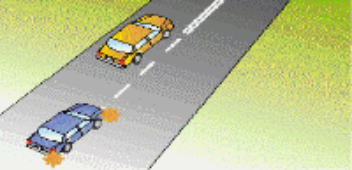Explanation:
To avoid causing other vehicles to brake, the safest method to enter a highway is to match your speed to that of the traffic you are merging with.
Explanation:
You can use the T2 lane if you have two or more people in your vehicle.
Explanation:
If there isn't enough room to depart the crossing in your selected lane, you must not enter the intersection.
Explanation:
A red light must not be crossed.
Explanation:
If the separating lines appear to be doubled and unbroken, you must not overtake.
Explanation:
Unless stopping abruptly might cause an accident, you should always stop when the lights turn yellow.
Explanation:
The traffic lights will control vehicle movements and direct traffic flow where there is just one lane for both traffic lines to offer a safer working environment for road workers.
Explanation:
Other drivers may begin a maneuver that clashes with yours if you don't signal in time, and if you don't check in your mirrors and over your shoulder, you may miss a vehicle in your blind zone.
Explanation:
You have the ability to cross an edge line.

Explanation:
If you find the separating lines are double and continuous, you are not allowed to pass the other vehicle.
Explanation:
If there is not enough space to exit the crossing in the lane of your choice, you must not enter the intersection.
Explanation:
If it is safe to do so, you may cross a double unbroken dividing line to access a driveway or piece of property.
Explanation:
Vehicle A is ahead of Vehicle B. Vehicle B has to yield.
Explanation:
Unless you are passing a bike, you must not cross an unbroken dividing line.
Explanation:
This lane is designated for light rail vehicles.
Explanation:
Always double-check your path before departing.
Explanation:
A yellow arrow indicates that the "protected" turning time period is coming to an end. Be ready to follow any further signals, including the red arrow, green or yellow light.
Explanation:
When a school bus has flashing red lights, kids may be getting off and walking across the street. As soon as the lights start flashing, you must stop and stay stopped.
Explanation:
Traffic officers' instructions take precedence over any signs, signals, or pavement markings. For instance, you must stop if a traffic police signals for you to do so at a green light. You must obey the officer's order to proceed through a stop sign or red light. Police officers, fire police, flaggers in work zones on the highway, and those at school crossings are among those with the authority to guide traffic.
Explanation:
Green arrows indicate "GO." You must yield to any vehicle, bicycle, or pedestrian still at the intersection before turning in the direction of the arrow. You are able to make a "protected" turn by using the green arrow. A red light stops approaching vehicles, bikes, and pedestrians as long as the green arrow is lighted.